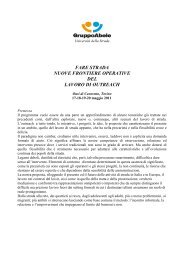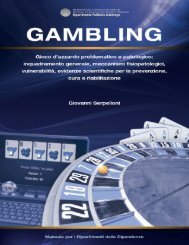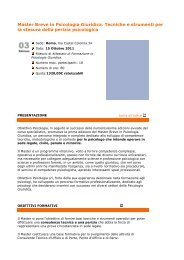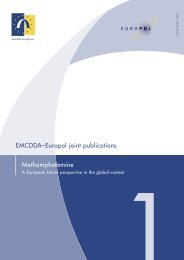Neuroscienze e dipendenze - Dipartimento per le politiche antidroga
Neuroscienze e dipendenze - Dipartimento per le politiche antidroga
Neuroscienze e dipendenze - Dipartimento per le politiche antidroga
Create successful ePaper yourself
Turn your PDF publications into a flip-book with our unique Google optimized e-Paper software.
ABSTRACT - 2° CONVEGNO NAZIONALE “NEUROSCIENZE OF ADDICTION”… - 279<br />
9%(p=0.13) in the globus pallidus, areas of preferential<br />
D3 binding. In the dorsal striatum MA, an area of low D3<br />
density, [11C]-(+)-PHNO was not different than control.<br />
Contrasting with the current PET/[11C]raclopride<br />
imaging literature suggesting D2 receptor down-regulation<br />
in PS users, these preliminary [11C](+)PHNO data<br />
suggest increased D3 receptors density in MA users. Our<br />
failure to detect decreased [11C](+)PHNO binding in<br />
dorsal striatum, an area where most [11C](+)PHNO<br />
binding is to D2 receptors might ref<strong>le</strong>ct an ectopic upregulation<br />
of D3 receptor in these regions - as reported<br />
in the preclinical literature.<br />
Up-regulation of the D3 receptor is suggested to be<br />
part of the neural adaptation which underlies sensitization,<br />
a process hypothesized to mediate drug, stress and cue induced<br />
relapse. Currently D3 receptor antagonists are being<br />
evaluated as anti-craving agents in clinical trials. Obtaining<br />
empirical brain imaging data on the status of the<br />
D3 receptor system in PS addiction can provide helpful<br />
information for evaluating this new therapeutic strategy.<br />
IMAGING FUNZIONALE E TRASMISSIONE<br />
DOPAMINERGICA NELLA DIPENDENZA<br />
DA COCAINE<br />
Diana Martinez<br />
Columbia University - New York, NY<br />
Previous human Positron Emission Tomography (PET)<br />
radioligand imaging studies have c<strong>le</strong>arly demonstrated<br />
that cocaine addiction is associated with a reduction in<br />
striatal dopamine signaling. As a result of these findings,<br />
recent studies have focused on the behavioral significance<br />
of the deficit, given that dopamine transmission<br />
plays an important ro<strong>le</strong> in the pathophysiology of addiction.<br />
Animal studies have shown that dopamine in the<br />
limbic striatum is crucial for se<strong>le</strong>cting adaptive, motivated<br />
behavior, and disrupted dopamine transmission is<br />
associated with impulsive, maladaptive behavior. Thus,<br />
the goal of our imaging studies in cocaine dependence is<br />
to investigate the ro<strong>le</strong> of dopamine signaling in the limbic<br />
striatum and how this correlates with cocaine seeking<br />
behavior and relapse. Previously, we have shown that<br />
dopamine signaling in the striatum, is predictive of the<br />
choice to self-administer cocaine in human cocaine dependent<br />
volunteers. In that study, cocaine dependent<br />
volunteers with low dopamine transmission were more<br />
likely to self-administer cocaine, suggesting that this may<br />
serve as a biologic marker for compulsive cocaine use.<br />
Thus, in more recent study, we investigated the correlation<br />
between striatal dopamine transmission and response<br />
to a behavioral treatment for cocaine dependence.<br />
This behavioral treatment uses positive reinforcement<br />
to encourage adaptive behavior in replace of<br />
impulsive cocaine use. The results of this study showed<br />
that low dopamine transmission was associated with a relapse<br />
and a failure to respond to treatment.<br />
This presentation will present this and other date<br />
from PET imaging studies, in conjunction with results<br />
from recent clinical trails, in order to discuss how this<br />
modality may be used to inform better treatment approaches<br />
for cocaine dependence.<br />
In humans, Positron Emission Tomography (PET)<br />
imaging studies have shown that cocaine dependence is<br />
associated with dysregulation of striatal dopamine transmission<br />
and that blunted dopamine re<strong>le</strong>ase is associated<br />
with cocaine seeking behavior. The goal of the present<br />
study was to investigate whether the degree of dopamine<br />
dysregulation predicted response to a behavioral treatment<br />
that seeks to replace impulsive cocaine use with<br />
constructive <strong>per</strong>sonal goals. The results showed that impaired<br />
dopamine re<strong>le</strong>ase in the limbic striatum was associated<br />
with relapse a poor response to treatment, whereas<br />
higher dopamine re<strong>le</strong>ase was associated with a positive<br />
treatment response. These findings provide insight into<br />
the neurochemistry of treatment response and failure,<br />
which can be used to develop future therapeutic strategies<br />
for individuals who strugg<strong>le</strong> with addiction.<br />
INTRODUZIONE ALLA NEUROPSICOLOGIA<br />
Daniela Mapelli<br />
<strong>Dipartimento</strong> di Psicologia Genera<strong>le</strong><br />
Università degli Studi di Padova<br />
La storia e l’evoluzione dello studio dell’attività cerebra<strong>le</strong><br />
umana risa<strong>le</strong> al <strong>per</strong>iodo Egizio e alla Grecia Classica, e<br />
successivamente si snoda e attraversa i lavori di Nemesio<br />
e Sant’Agostino, Ga<strong>le</strong>no e Andrea Vesalio, fino a Gall e<br />
Flourens. Questa lunga storia aiuta a comprendere il panorama<br />
nel qua<strong>le</strong>, alla fine dell’ottocento, grazie ai lavori<br />
di Broca, Wernicke, Goldstein e Luria, nacque il concetto<br />
di sistema funziona<strong>le</strong> e con esso la piena autonomia<br />
della Neuropsicologia Cognitiva come scienza.<br />
Fino agli anni ’90 la neuropsicologia è stata una disciplina<br />
preva<strong>le</strong>ntemente focalizzata sullo studio s<strong>per</strong>imenta<strong>le</strong><br />
di singoli pazienti e/o di gruppi che, attraverso<br />
l’utilizzo della metodologia s<strong>per</strong>imenta<strong>le</strong>, hanno contribuito<br />
ad ampliare <strong>le</strong> conoscenze dei processi cognitivi.<br />
Oggigiorno grazie alla diffusione del sa<strong>per</strong>e neuropsicologico,<br />
la disciplina è ampliamente utilizzata in ambito<br />
clinico oltre che in quello s<strong>per</strong>imenta<strong>le</strong>. Secondo Lezak<br />
e col<strong>le</strong>ghi (2004) la neuropsicologia, nei suoi molteplici<br />
campi di applicazione, può essere genericamente definita<br />
come la “scienza applicata che riguarda l’espressione<br />
comportamenta<strong>le</strong> di disfunzioni cerebrali.<br />
Gli attuali campi di applicazione sono molteplici: in<br />
ambito diagnostico,clinico, in ambito forense, in ambito<br />
riabilitativo.<br />
Brevemente gli obiettivi della neuropsicologia clinica












